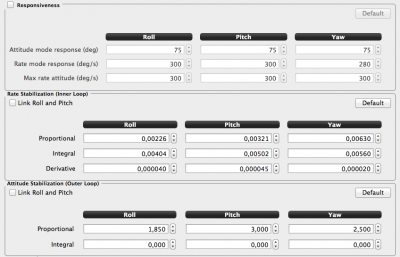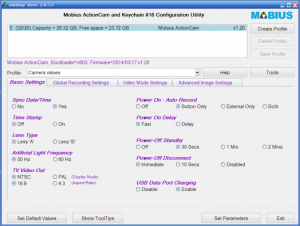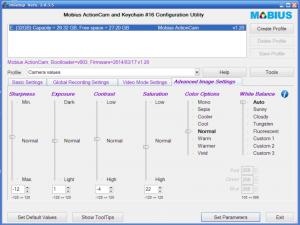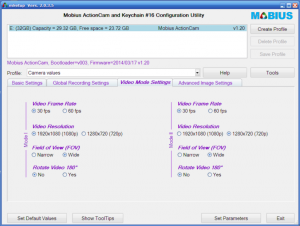Lumenier QAV250 Setup: Difference between revisions
No edit summary |
|||
| Line 6: | Line 6: | ||
The CC3D and Naze32 Acro is at the time the best flight controllers for this platform. The CC3D is suggested by Lumenier and is used in this setup. | The CC3D and Naze32 Acro is at the time the best flight controllers for this platform. The CC3D is suggested by Lumenier and is used in this setup. | ||
How to tune Kp: | How to tune Kp - how to get fast corrective response: | ||
# Set Ki for roll and pitch to 0.00300, put the responsiveness for rate mode response and max rate attitude to 300deg/sec for all | # Set Ki for roll and pitch to 0.00300, put the responsiveness for rate mode response and max rate attitude to 300deg/sec for all | ||
# Enable TxPID and put Kp roll and pitch on two sliders, set min. to 0.00100 and max. to 0.00500 - this pits the slider center to 0.00300 | # Enable TxPID and put Kp roll and pitch on two sliders, set min. to 0.00100 and max. to 0.00500 - this pits the slider center to 0.00300 | ||
# Start flying in rate mode (pitch and roll), make quick stick movements and listen to how the controller ''stop'' when it has done the movement (counter adjust to stop it from getting away) | # Start flying LOS in rate mode (pitch and roll), make quick stick movements (start with pitch) and listen to how the controller ''stop'' when it has done the movement (counter adjust to stop it from getting away) | ||
# If you you hear a quick double wrrh-wrrh, i.e. it overshoots/corrects, the rate is too high, lower and try again, the response should be precise with no sudden motor responses when it has hit the final position/angle | # If you you hear a quick double ''wrrh-wrrh'', i.e. it overshoots/corrects, the rate is too high, lower and try again, the response should be precise with no sudden motor responses when it has hit the final position/angle | ||
# Do the same for roll - on a H-quad the pitch rate is normally a little higher than the roll rate because of the weight distribution and delay in angular acceleration/momentum | # Do the same for roll - on a H-quad the pitch rate is normally a little higher than the roll rate because of the weight distribution and delay in angular acceleration/momentum | ||
How to tune Ki - how to keep the platform at an angle: | |||
# After Kp is tuned, put Ki for roll and pitch on two sliders, set min. to 0.00100 and max. to 0.00700 - this pits the slider center to 0.00400 | |||
# Put the slider low to get a value of about 0.00100, start flying LOS in rate mode, and roll to the right at a fairly steep angle, see how it holds the angle - it will most certainly loose the angle and level out | |||
# Adjust the value up and try again, increase until the angle is holding for a fairly long distance (10-20m) | |||
# Do the same for pitch - the pitch value will also be a bit higher then roll | |||
# With the final values set, re-test the Kp value by redoing the steps above | |||
How to tune Kd - how to add a small amount of breaking to Kp: | |||
# Add the Kd on two sliders, set min to 0.000000 and max. to 0.00090 - this puts the center at 0.00045 | |||
# Turn down the sliders to zero and start flying to get a feeling of how quick roll stick angle changes feels or looks in the goggles - should be very crisp and maybe a bit of overshoot/wiggle at the end of the correction | |||
# Increase the roll slider and see how the breaking of the Kd dampens the end of the angle correction - Kp should have a diminishing effect and slow down as it approaches the set angle | |||
# Keep the value low for good fast response and increase to add smoothness to video footage/goggles | |||
PID settings: | PID settings: | ||
Revision as of 22:52, 1 May 2014
The following is my own QAV250 setup log/configuration.
OpenPilot Flight Controller
The CC3D and Naze32 Acro is at the time the best flight controllers for this platform. The CC3D is suggested by Lumenier and is used in this setup.
How to tune Kp - how to get fast corrective response:
- Set Ki for roll and pitch to 0.00300, put the responsiveness for rate mode response and max rate attitude to 300deg/sec for all
- Enable TxPID and put Kp roll and pitch on two sliders, set min. to 0.00100 and max. to 0.00500 - this pits the slider center to 0.00300
- Start flying LOS in rate mode (pitch and roll), make quick stick movements (start with pitch) and listen to how the controller stop when it has done the movement (counter adjust to stop it from getting away)
- If you you hear a quick double wrrh-wrrh, i.e. it overshoots/corrects, the rate is too high, lower and try again, the response should be precise with no sudden motor responses when it has hit the final position/angle
- Do the same for roll - on a H-quad the pitch rate is normally a little higher than the roll rate because of the weight distribution and delay in angular acceleration/momentum
How to tune Ki - how to keep the platform at an angle:
- After Kp is tuned, put Ki for roll and pitch on two sliders, set min. to 0.00100 and max. to 0.00700 - this pits the slider center to 0.00400
- Put the slider low to get a value of about 0.00100, start flying LOS in rate mode, and roll to the right at a fairly steep angle, see how it holds the angle - it will most certainly loose the angle and level out
- Adjust the value up and try again, increase until the angle is holding for a fairly long distance (10-20m)
- Do the same for pitch - the pitch value will also be a bit higher then roll
- With the final values set, re-test the Kp value by redoing the steps above
How to tune Kd - how to add a small amount of breaking to Kp:
- Add the Kd on two sliders, set min to 0.000000 and max. to 0.00090 - this puts the center at 0.00045
- Turn down the sliders to zero and start flying to get a feeling of how quick roll stick angle changes feels or looks in the goggles - should be very crisp and maybe a bit of overshoot/wiggle at the end of the correction
- Increase the roll slider and see how the breaking of the Kd dampens the end of the angle correction - Kp should have a diminishing effect and slow down as it approaches the set angle
- Keep the value low for good fast response and increase to add smoothness to video footage/goggles
PID settings:
FPV Pilot Camera
- CMQ-1993 600TVL camera with IR filter - vibrant colors
- 2.8 mm lens - nice balance between narrow and wide-angle view
The CMQ-1993 600TVL camera provides an excellent picture for a reasonable price (45USD). There are only a few settings needed to be changed to improve the picture quality. It renders colors great and it quickly adapts to changing light conditions. A detachable configuration/menu board is included.
Do a rest to defaults before setting the following options, mainly the brightness, contrast, sharpness and color levels using this setup guide pt1 and pt2, this guide or this.
Settings - value in (value) is the defaults:
- Exposure:
- Shutter speed: Auto (Auto)
- Brightness: 042 (042) - range seems to be 22 to 65
- AGC: Off (Middle)
- DWDR: On (Off) - Most important
- Level: 063 (063)
- White balance: ATW1 (ATW1)
- Day and night: Color (Auto)
- Image adjust:
- Lens Shade: On (Off)
- Level: 80 (22)
- Contrast: 105 (149)
- Sharpness: 023 (026)
- Display: LCD (CRT)
- Gamma: 0.45 (LCD 0.45 CRT -)
- Ped level: 026 (LCD 017 CRT 016)
- Color gain: 250 (LCD 176 CRT 160)
- Lens Shade: On (Off)
PZ0420 no IR-block filter settings:
- Exposure:
- Shutter speed: Auto (Auto)
- Brightness: 065 (042) - range seems to be 22 to 65
- AGC: Off (Middle)
- DWDR: On (Off) - Most important
- Level: 063 (063)
- White balance: ATW1 (ATW1)
- Day and night: Color (Auto)
- Image adjust:
- Lens Shade: On (Off)
- Level: 80 (22)
- Contrast: 105 (149)
- Sharpness: 028 (026)
- Display: LCD (CRT)
- Gamma: 0.45 (LCD 0.45 CRT -)
- Ped level: 050 (LCD 017 CRT 016)
- Color gain: 250 (LCD 176 CRT 160)
- Lens Shade: On (Off)
This should give excellent piloting picture in any goggle or display. Perform fine-tuning at the flight location to lock-in the image quality even further.
Mobius HD camera
The Mobius is an amazing value, the picture quality is something which is comparable to GoPro HD Hero cameras but at a very reasonable price.
To configure the camera, either do it by hand by opening the SYSCFG.TXT file or get the Mobius Configuration application. To manually edit the file, enter the config mode by holding the Mode button, wait 1 sec, then also press the Power button, wait 10 sec and 3 red blinks, connect it to USB and a SYSCFG.TXT should be at the root of the drive.
Essential settings:
- Artificial light frequency: 50Hz in EU/AU, 60Hz in US
- Date stamp: Off
- Power-on auto record: On - less buttons to press
- Wide dynamic range: On
- Video data rate: High - 18MBit/s less artifacts
- Video clip length: Max. (4GB)
- Image settings:
- Sharpness: -12
- Exposure: 1 - makes a huge difference, only a single step
- Contrast: -4
- Saturation: 22




